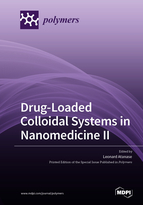Drug-Loaded Colloidal Systems in Nanomedicine II
A special issue of Polymers (ISSN 2073-4360). This special issue belongs to the section "Polymer Networks".
Deadline for manuscript submissions: closed (31 May 2022) | Viewed by 28483
Special Issue Editor
2. Academy of Romanian Scientists, 050045 Bucharest, Romania
Interests: block and graft copolymers; micelles; colloids; emulsions; drug delivery; polysaccharides
Special Issues, Collections and Topics in MDPI journals
Special Issue Information
Dear Colleagues,
Further to the success of the Special Issue of Polymers “Polymeric Colloidal Systems in Nanomedicine”, I am delighted to reopen this Special Issue, now entitled “Drug-Loaded Colloidal Systems in Nanomedicine II”.
This Special Issue will integrate fundamental research with the practical application of colloidal systems in the field of nanomedicine. Of practical interest are the drug-loaded colloidal systems, such as micelles, polymersomes, nanogels, liposomes, nanocapsules, polymeric, inorganic nanoparticles, etc., with diameters in the range of 10 nm to 400 nm. Another domain of interest is that of functionalized colloidal systems with specific ligands for active targeted drug delivery.
The authors will try to explain the correlations between the molecular characteristics of the starting polymers and colloidal characteristics, as well as the encapsulation efficiency and/or the drug release kinetics. In vitro biological analyses are welcome but not mandatory. Regular research articles and reviews will be accepted for publication in this Special Issue.
Prof. Dr. Leonard Atanase
Guest Editor
Manuscript Submission Information
Manuscripts should be submitted online at www.mdpi.com by registering and logging in to this website. Once you are registered, click here to go to the submission form. Manuscripts can be submitted until the deadline. All submissions that pass pre-check are peer-reviewed. Accepted papers will be published continuously in the journal (as soon as accepted) and will be listed together on the special issue website. Research articles, review articles as well as short communications are invited. For planned papers, a title and short abstract (about 100 words) can be sent to the Editorial Office for announcement on this website.
Submitted manuscripts should not have been published previously, nor be under consideration for publication elsewhere (except conference proceedings papers). All manuscripts are thoroughly refereed through a single-blind peer-review process. A guide for authors and other relevant information for submission of manuscripts is available on the Instructions for Authors page. Polymers is an international peer-reviewed open access semimonthly journal published by MDPI.
Please visit the Instructions for Authors page before submitting a manuscript. The Article Processing Charge (APC) for publication in this open access journal is 2700 CHF (Swiss Francs). Submitted papers should be well formatted and use good English. Authors may use MDPI's English editing service prior to publication or during author revisions.
Keywords
- Polymeric colloids
- Micelles
- Nanogels
- Liposomes
- Nanoparticles
- Drug delivery
Related Special Issue
- Polymeric Colloidal Systems in Nanomedicine in Polymers (6 articles)







